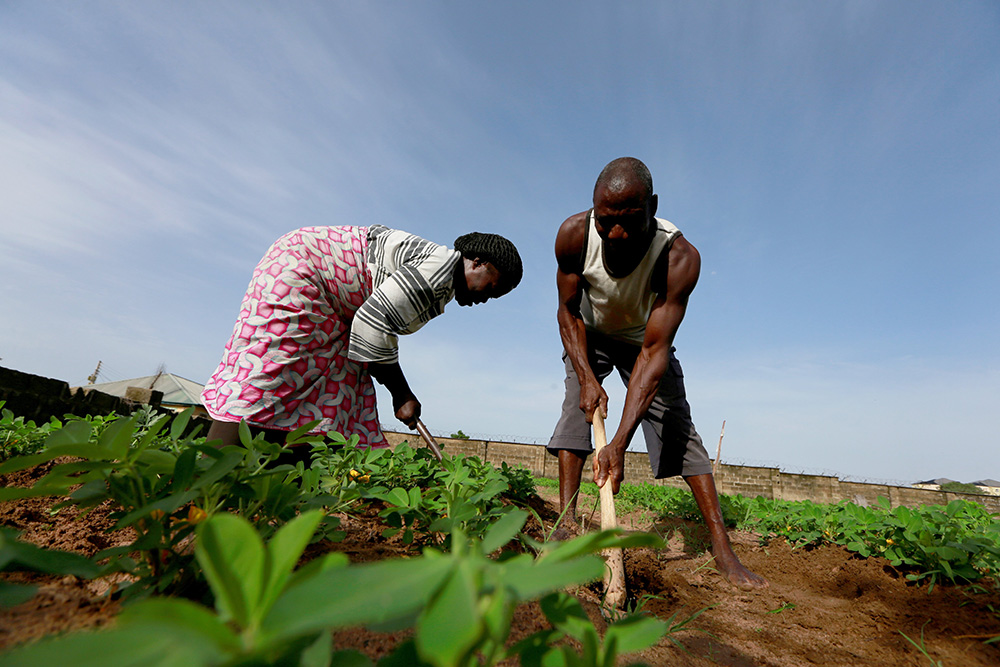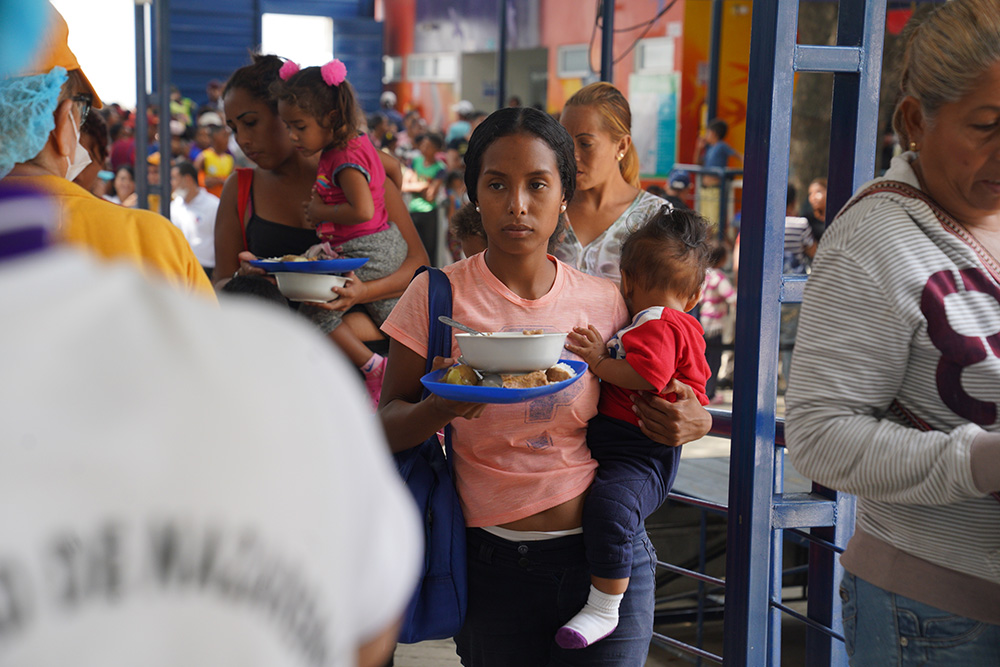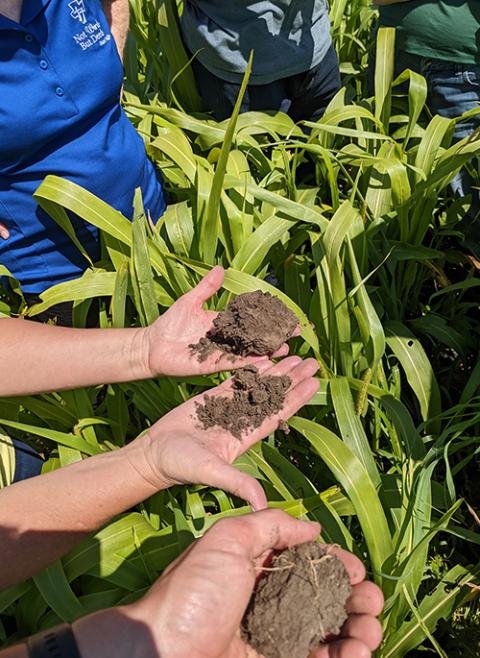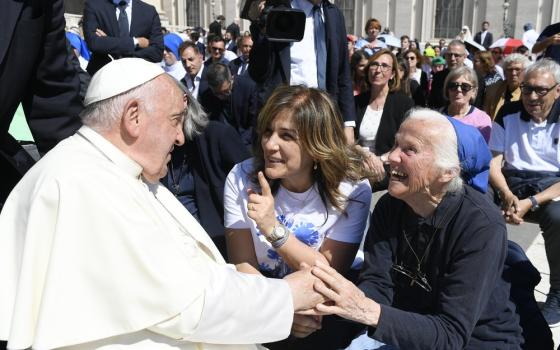
A husband and wife work on their farm in Abuja, Nigeria, June 10, 2020. (CNS/Reuters/Afolabi Sotunde)
Hunger is a word that has caught my attention recently and led me into reflecting on four of its dimensions: human hunger, Earth's hunger for restoration and relationship, hunger for voice, and hunger for heart intelligence.
Our world is in a crisis of hunger, of food insecurity. I read about it every day. A recent 2023 Global Report on the Food Crises notes that the Sustainable Development Goal to end hunger by 2030 appears to be slipping away. The report estimates that nearly 300,000 million people in 58 countries were acutely food insecure at the end of 2022 and the numbers keep increasing.
I became more aware of this last year when the Hilton Foundation gave the Humanitarian Prize of $2.5 million to the Norwegian Refugee Council. This organization described the huge problem it faces with food shortages, and they are not alone. Nearly, if not all relief groups experience the same, responding to the plight of thousands of families fleeing from their homes because of conflict, climate and economic shocks.
The war in Ukraine has exacerbated the issue throughout the world as Ukraine and Russia were countries that provided significant commodities of wheat, corn, sunflower oil and of course fuel for transporting them worldwide. Because of our global interconnectedness, this distress impacts all of us in some way. Unfortunately, in my part of the world, those kept poor bear the greatest burden of the pain, particularly higher food prices.

A Venezuelan migrant and her child receive a meal at the Divine Providence Food Pantry in Cucuta, Colombia, Jan. 31, 2020. (CNS/Manuel Rueda)
So, what solutions for food insecurity are being implemented? Scientists and international relief organizations are busily looking for "fixes" to "modify" food filled with calories but not nutrition. The lack of nutrition has resulted from worldwide monoculture farming that degrades soil and destroys biodiversity. So, rather than going to the root of the problem, regeneration of soil, we need to add vitamins and other nutrients to make food nutritious.
Such short-term fixes are not sustainable. What about the future of food?
Thankfully, long-term solutions are being initiated by individuals and local grassroots organizations of farmers, among them sisters. Their action is the necessary response to the most basic hunger that needs addressing — the hunger of the Earth for restoration and just relationship with us humans.
As we regain a right relationship with the Earth and assist its restoration, bringing back all the missing microbes needed to produce healthful food, the hunger of families and communities will be satisfied. Nutritious, not just calorie-dominated, food will be their fare and more than likely health care expenses will be reduced that now bleed away so many families' resources.

Regenerative farming expert Gabe Brown, Presentation Sr. Janice Klein and others examine soil on his farm in North Dakota. Regenerative farming focuses on restoring the health of soil through natural means. (Presentation Sisters of the Blessed Virgin Mary/Jared Hohn)
These worldwide grassroots movements are engaging in regenerative, permaculture and restorative farming, just to name a few. Each is a different approach to agriculture. Farmers have learned that it is our soil that hungers for regeneration and relationship with us, and they are willing to take the time and effort to restore these relationships. Restoration farmers seek to restore original eco-systems.
However, there are also strong voices of resistance, voices for profit and fear of change. Many also argue that small farms will not feed the world. And their solution is to keep buying more land to plant the four major crops that provide our food: wheat, corn, soy and rice that are planted over and over and deplete the soil of its original life.
Small farmers in the Global South, who are estimated to already produce a third of the world's food, do not have the advantage of capital to purchase more land. Most have only a few acres, and yet ironically they are among those taking the first steps to restore relationship with the Earth, soil and the biodiversity of nature. Their efforts refute the voices of dissent.
It is also amazing to read that about 43% of these small farms are managed by women and girls worldwide. In Africa, close to 60%, and 45% in Asia/Pacific.
Sisters are a major cohort of these percentages. Sisters share the fate of the women farmers of their countries, invisible and yet longing to serve their own people and the Earth and desiring to thrive into the future.
It is no wonder that a third hunger is the longing of women, children and Indigenous peoples to be recognized and heard. However, listening takes time, something dominant cultures do not seem to value. Listening deeply takes a different kind of intelligence than that of the brain.
Sr. Veronica, a member of the Little Sisters of St. Francis, is seen in January 2020 holding a pea pod harvested from the Divine Mercy Green Farm her order operates in Nakuru, Kenya. The farm received a startup loan of $100,000 from the Missio Invest Social Impact Fund to expand its work in the local community. (CNS/Handout, Missio Invest, Pontifical Missionary Societies in the United States)
As the Little Prince says in the book of that name: "It is only with the heart that one sees rightly." It is the listening heart that can take in those unheard voices of women, children, the Earth and Indigenous peoples, those most impacted by the issues of soil degradation, hunger and lack of health care.
And that is the fourth hunger — that of our own hearts, also longing to be recognized and heard. Although we idolize brain power, according to current neuroscience research, the heart has a 5,000 times wider electromagnetic field than does the brain. That means our hearts take in 5,000 times more information from our surroundings than the brain.
We need heart education to learn how to use this resource, not only emotions, but intuitions, feelings we push aside that make us uncomfortable, hunches that come to us out of the blue that we ignore and later regret. Using heart intelligence determines the kind of presence we bring to any situation or issue.
Many of us these days are practicing contemplative prayer that assists in integrating heart energies. We long to be contemplatives in action.
But many of us are bent on results, not now but yesterday, forgetting that change or transformation takes time. Vision has its own rhythms and needs for space to evolve. It requires patience and commitment even if only small steps.
A story from the Middle Ages helps me remember this truth. We are told that a person walking along the street sees someone laying bricks and comments: "I see you are a bricklayer, building a wall?"
Advertisement
The bricklayer stops for a moment, looks up and responds gently, "No, I am not a bricklayer, I am a builder of cathedrals."
The bricklayer has a larger vision of her seemingly small, and perhaps to others, insignificant action. She sees what she is doing in a long-term vision, something far beyond the part she is playing. Her vision is transgenerational, similar to our Native Americans practice in decision-making — keeping in mind the seventh generation.
Intergenerational decision making, contemplative decision-making requires questions of the heart: Alan Seale suggests three that lead us beyond usual problem solving.
- What wants to happen here?
- Who is the situation asking me to be?
- What is the situation asking me to do?
In other words, what is the opportunity available right now? The breakthrough waiting to happen? What is the situation revealing or emerging?
Who is the situation inviting me to be? What kind of presence is being invited for leadership and stewardship of the emerging potential (courage, truthfulness, playfulness, creativity, other)?
And what is the call to action – emphasis on "call," not taking control and figured out by the brain. What is sensed, intuited, that wants to happen, the next step that can be assisted for the emerging moment of its evolution?
These are seventh-generation questions, questions of contemplatives in action.
They can lead us to insight into how to assist in addressing four hungers for justice in our world: human hunger; Earth hunger; hunger of women, children and Indigenous people to have voice in addressing issues that impact them; and the hunger of our own hearts to be deeply listened to in prayer, decision-making and action.







